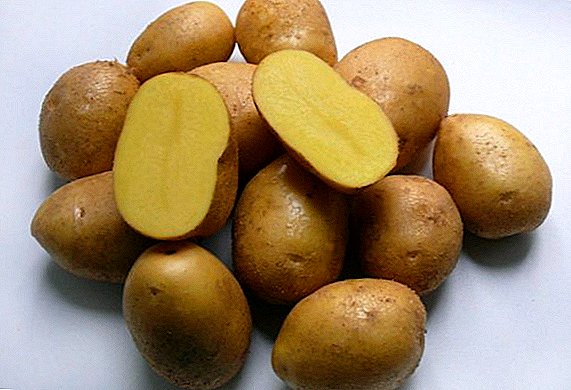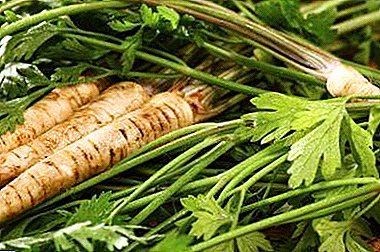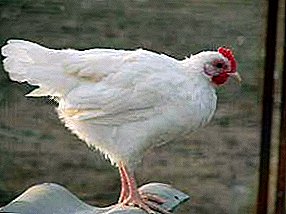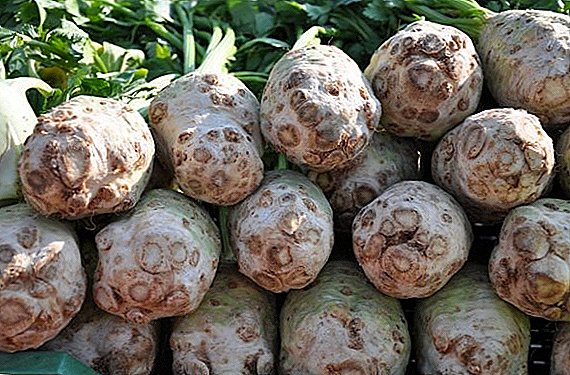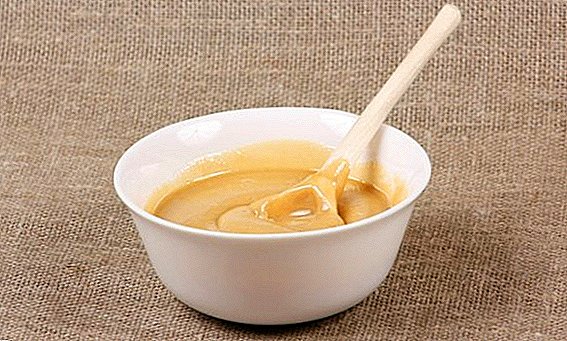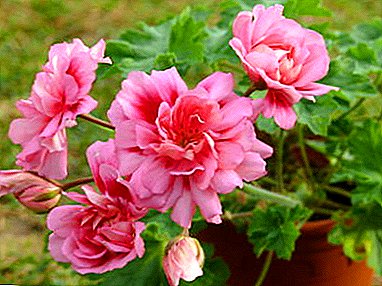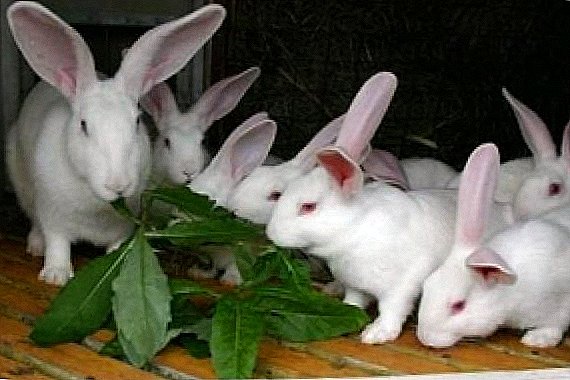 Currently, the breeding of rabbits is successful - a branch of the national economy, which brings a huge profit. Animals are raised for great fur and dietary meat. Now there are about 90 species of rabbits, which are bred for industrial increase in livestock, and also contain as pets.
Currently, the breeding of rabbits is successful - a branch of the national economy, which brings a huge profit. Animals are raised for great fur and dietary meat. Now there are about 90 species of rabbits, which are bred for industrial increase in livestock, and also contain as pets.
Each breed has its own advantages and disadvantages. In general, all species of rabbits are highly productive; therefore, both private and state animal breeding farms are engaged in breeding them. In this publication, we consider the features of the white giant rabbits.
For many, the big white rabbit is a favorite character in L. Carroll's fairy tale! This is a beautiful friendly animal that is loved by both children and adults, so it is happy to keep it at home.
For a long time, breeders worked to bring out animals with a pure white color, as a result rabbits of white giant breed appeared. They quickly gained recognition from the general public, and also became popular among domestic and foreign fur farmers. Currently, they are bred on an industrial scale for the sake of beautiful fur and valuable dietary meat. What features of the breed and what are the basic principles of its breeding, you will learn from this publication.
Description
 The White Giant is a Belgian meatshkurnaya breed, which appeared as a result of the painstaking and difficult selection of albino rabbits of the Flandre breed. The animal was first brought to Russia from Germany in 1927.
The White Giant is a Belgian meatshkurnaya breed, which appeared as a result of the painstaking and difficult selection of albino rabbits of the Flandre breed. The animal was first brought to Russia from Germany in 1927.
In the USSR, Soviet specialists worked to improve their breed qualities. As a result, the white giant breed was improved by following the path of purebred breeding and introductory crossing of chinchillas with rabbits of the gray giant and flandre.
Breed is widespread, it is often bred on private farms and in individual farms. Currently, the most valuable livestock of such rabbits are concentrated in the Tula and Krasnoyarsk Territories, in Tatarstan, the Leningrad and Kursk regions.
Appearance
 Modern representatives of the breed are distinguished by a large body weight (an average of 5.1 kg). As a rule, they are not heavier than 8.3 kg and not less than 4.3 kg. These are large individuals, whose body length reaches 60 cm and is never less than 59 cm, while the girth of a deep and narrow chest is 37 cm, with a large demi-breast - 39 cm. They have rounded croup with well-pronounced thighs.
Modern representatives of the breed are distinguished by a large body weight (an average of 5.1 kg). As a rule, they are not heavier than 8.3 kg and not less than 4.3 kg. These are large individuals, whose body length reaches 60 cm and is never less than 59 cm, while the girth of a deep and narrow chest is 37 cm, with a large demi-breast - 39 cm. They have rounded croup with well-pronounced thighs.
Their body is elongated, the stocky constitution is strong, and the bones are thin. On the long head are wide and long ears (15-18 cm). It is a long-legged tribe with red eyes and a long, fluffy hairline. Animal fur is thick and shiny, but not as resilient and resilient as chinchillas. Down hairs are a little twisting. There are about 23 downy hairs per hairline. Fur farmers receive large skins, which are often given the color of expensive fur.
The natural color of the fur is only white without inclusions and impurities, this is due to the fact that pedigreed individuals contain the gene for albinism.
Productivity
 This is an early breed with a quick payback of feed, already in 4-month-old rabbits a large average daily weight gain. Two-month weighs 1, 5 kg, three-month-already 2 kg, and four-month-old weigh about three kg (an average of 2.6 kg). By weight, young individuals are divided into types and classes.
This is an early breed with a quick payback of feed, already in 4-month-old rabbits a large average daily weight gain. Two-month weighs 1, 5 kg, three-month-already 2 kg, and four-month-old weigh about three kg (an average of 2.6 kg). By weight, young individuals are divided into types and classes.
Representatives of this breed are often crossed with other breed groups to obtain new species.
Features breeding, care
 It is vital to keep such animals clean: clean the cells in time and disinfect at least twice a year. If a new individual or group of animals is poured into the livestock, they should be kept in quarantine, get a closer look, sanitize their cells and only after that allow them to enter the main population.
It is vital to keep such animals clean: clean the cells in time and disinfect at least twice a year. If a new individual or group of animals is poured into the livestock, they should be kept in quarantine, get a closer look, sanitize their cells and only after that allow them to enter the main population.
If the animal is sick, it is isolated from the general population, as well as the cantata group of individuals, and their cells are disinfected. This is a good preventive measure that allows you to avoid many ailments.
It is easy to breed such individuals, they are constantly and year-round ready to mate. To mating allow 5-or 6-month-old males. It is dangerous to hold them back, they quickly recover and become passive.
Before mating, the trough and the feeder are removed from the male's cage. The cage of the female is prepared for okolu (cleaned and disinfected), in her to put wood chips (better spruce) put hay or straw on top. From it the expectant mother will build a nest.
This must be done, because otherwise the female has nothing to build a nest for, and the cubs can die. Use alone sawdust is prohibited, because they are often clogged with a newborn in all holes (nose, ears and eyes). In addition, the mother liquor is organized, measuring 35 x 60 x 30 cm, is placed on the left or the right along the entire length of the cage, and the lid is placed on top in order to easily inspect the nest from above.
The cage should be spacious, it can not be put in the sun, in the cold season it is sheltered from wind and rain, sometimes warmed. It should not create drafts. As a defense against unwanted guests (rats, mice, etc.), the floor and sides of the cage are covered with tin. The cells are arranged in two tiers, with the doors making the mesh and using the original safety valves. Tanks for feeders and drinkers is better to use metal. Before capping, the cells are cleaned and further disinfected.
Virtues
The uniqueness of the breed is considered extremely high dairy females, they are able to generate up to 220 g of milk per day (at least 200g), almost like Soviet chinchillas. This makes it possible to raise the young as a broiler. Successful farmer breeders at home plots achieve fantastic results, their 2-month-old babies weigh about two kilograms.
Females litter does not exceed 7-8 puppies, it is estimated as a good indicator of fecundity.
Representatives of this breed are recommended by experts for interbreeding.
They have a calm disposition, they get on well with both adults and children, so they are kept as a pet.
disadvantages
The weight and size characteristics of pedigree specimens make their maintenance in enclosed spaces impractical; they feel better in large open-air cages. If they are grown indoors, they often suffer from dermatitis and mastitis, moreover, they give a higher than usual percentage of marriage at the 1st and even 2nd rounds. In females, after 2-3 hours, mastitis often occurs if they are kept in a buried room.
Often among the representatives of the breed appear pampered individuals with a loose constitution, chopped off croup and interception of the breast behind the shoulder blades. Sometimes rabbits are born with insufficiently pubescent paws or individuals with fur similar to the wool of downy rabbits "chubby". All this is attributed to the main breed deficiencies, such individuals are not bred.
Feeding features
These magnificent fluffy animals are unpretentious in care and are not selective in food. They are fed the same way as rabbits of other breeds. A special diet is introduced for pregnant females and young animals. First of all, they use only fresh fresh vegetables, grass, hay, and grains. If necessary, the feed is enriched with vitamins and microelements. Grain is given in a crushed form, for this purpose they use a grain crusher.
In addition to size, giants are no different from decorative dwarf species, so they are often kept at home, despite their large size. Certainly this is a very beautiful rabbit that pleases the eye and improves mood. In order for him not to methyl territory in the house, then up to 4 months it must be neutered. If animals are fed dry food, they need to be provided with constant access to fresh water.
There are cases when adult individuals (even females who are waiting for okrol) refuse water, it is considered to be quite normal because it indicates that there is enough water in the diet of such an individual. Fur farmers recommend giving them "vinaigrette"This is a special dish that must be cooked for two hours. It consists of vegetable feed, as well as the remnants of fruits and vegetables. They are crushed, boiled, cooled, drained and given to breakfast for pets. In the salad, you can add boiled vegetables that are not fed raw. It can be a squash, pumpkin or potato, and nettle, quinoa and corn stalks are added to it. In the summer you can enter the young shoots of trees and green grass.
In the autumn, it is worth harvesting food: woody leaves, as well as tomato, cucumber, pumpkin, corn, beans, sunflower and other tops. In winter, mainly hay and grain are fed, in the form of treat, you can give bread soaked with milk for dinner.
Okrol
 Experienced animal producers plan mating and okroly, making special schedules. The best breeding offspring collected from the winter, spring and summer okrolov. In the fall, they get slaughtered meat individuals, because they quickly gain weight.
Experienced animal producers plan mating and okroly, making special schedules. The best breeding offspring collected from the winter, spring and summer okrolov. In the fall, they get slaughtered meat individuals, because they quickly gain weight.
Three or four hours before giving birth, the future mother rabbit rubs the litter creating a nest, then she plucks the fluff on her stomach and covers the surface with it. During a round, the female needs quick and easy access to drinking water. Most often, the process takes place at night and lasts at least 10 minutes and no longer than an hour. After birth, the mother licks the babies, lays them in the nest and covers them with fluff.
The females are milk-rich, in this case 8-10 babies are left under them, if the mother is milk-normally, then 6-7 babies are left with her, if the mother has no milk (this is very rare) or if the brood number is more than usual, then such fluffies are planted the nest in which little rabbits.
It’s not so easy to make babies sit down, it should be done very carefully. Pre-mother is removed from the cage, rabbit immigrants, cleaned of fluff and straw, and placed in the center of the step nest, covering with fluff from another nest. Please note that immigrant newborns should not be very different in height and weight from babies from someone else's nest.
Rabbit Care
The cage with newborns must be placed in a quiet quiet place, where there are no drafts. Mother with offspring should be in conditions of peace and tranquility. Animals can only be touched as a last resort. All manipulations with them must be carried out smoothly, without abrupt and rough movements.
After the female brought the litter, the cattle must carefully examine the newborn, the dead individuals must be removed from the nest, and the healthy ones should be left. Before inspection, wash hands thoroughly and wipe them down. Babies are also examined at 2 months of age. At this time, they are covered with hair perfectly see and hear. The babies are weak, apathetic, with dull eyes and dull matted hair taken from the nest. For summer and autumn hares need extra care, they grow more slowly.
Already on day 16-20, babies make attempts to leave the nest. It is possible to separate babies from mom only when they have ended the nursing period, usually 3 months after birth. It is impractical to buy or sell 2-month-old cubs, they are very weak, their immunity completely depends on the quantity and quality of mother's milk. In addition, they have a strong physiological and psychological attachment to the mother.
Tribal (repair) babies are deposited on the 60th day of birth, they are settled in four in a cage, separately for females and males. Three-month-old males are divorced one at a time in different cells, and females settle in two per cage.
Fattening youngsters can be removed after 40-45 days, they are settled in groups of five or six individuals. At first, the young stocked up are fed as they fed their mothers, gradually introduce new foods or change the diet as a whole. Rabbits get used to new products for a long time.
In three-month individuals, it is important to determine sex at the right time. At this age, the difference between male and female genitalia can be subtracted. The animals are turned over onto their backs, with one hand held behind the neck, the other by the tail and pressed against the area near the anus. In females, you can see the original loop of pink color, which narrows towards the tail, and the males can clearly see a small cylinder with a hole in the top.
 After determining the gender, it is necessary to strictly distinguish between males and females in order to eliminate the chaotic coverings of the young. Tribal males can not be kept in groups, because during puberty, they begin to fight and are capable of inflicting injuries to each other, incompatible with life. There have been cases when a stronger individual has cut off a competitor's ovaries.
After determining the gender, it is necessary to strictly distinguish between males and females in order to eliminate the chaotic coverings of the young. Tribal males can not be kept in groups, because during puberty, they begin to fight and are capable of inflicting injuries to each other, incompatible with life. There have been cases when a stronger individual has cut off a competitor's ovaries.
Case individuals need in a timely manner. They can not be overpowered, overfeeding or underfeeding, all this reduces the reproductive capacity of the individual, it copulates apathetically and brings inferior offspring.
Settled young individuals that are lagging behind in development are intensively fed and not bred. They are "rejected" and formed into separate groups.
In order to mark the rabbit he gets a tattoo. To do this, take the ear of a 30-45 day old baby, rub it with an alcohol swab, draw the paint and the desired number into the tattoo syringe, make a puncture closer to the outer edge of the ear (between the middle and the outer border) and mascara flow into the wound. A serial number is written on the right ear, on the left - the month and year of birth (last digit).



